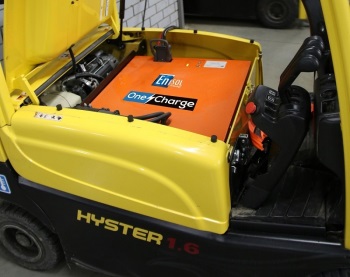Complete Powerpoint slide presentation for forklift instructors. Ready made training course
lithium ion batteries on forklift trucks
 Below is an article by Flashbattery, which looks at the advantages of Lithium Ion batteries compared to lead acid batteries used on forklift trucks. To be fair, Lucas have developed a special lead acid battery which overcomes some of these deficiencies. The article is arranged in the form of headlines and the writer suggests they could write a book on the subject!
Below is an article by Flashbattery, which looks at the advantages of Lithium Ion batteries compared to lead acid batteries used on forklift trucks. To be fair, Lucas have developed a special lead acid battery which overcomes some of these deficiencies. The article is arranged in the form of headlines and the writer suggests they could write a book on the subject!
Charging the battery
Lead Acid battery: The charging efficiency of this type of battery is low – only 70%! A lead-acid battery needs more energy for recharging than it delivers. The excess energy is used for gasification and for mixing the acid internally. This process warms up the battery and evaporates the water inside, which results in the need to top up the battery with distilled (demineralised) water. Lead-acid recharging has severe limitations and a number of critical points. Here are the most important ones:
- Fast or partial charges ruin a lead-acid battery
- Charging times are long: from 6 to 8 hours
- The charger does not collect full information on the battery. It only checks the voltage, and that’s not enough. Changes in temperature affect the recharge profile, so if the temperature is not measured, the battery will never charge completely in winter and will gasify too much in summer
- An incorrect charger or setting reduces battery life
- Poor maintenance will also reduce battery life
Lithium ion battery: Lithium-ion batteries can be “fast” charged to 100% of capacity.
A lithium battery saves on your electric bill, as it is up to 96% efficient and accepts both partial and rapid charging.
A lithium battery can be charged to 50% capacity in only 30 minutes. This innovative characteristic enables our customers to equip their devices with lower installed battery capacity than the capacity required with lead-acid batteries, because lithium batteries can be recharged repeatedly over a short time.
Electronic systems inside the battery control the charger effectively, so it can deliver the exact current that is consistent with internal parameters (voltage, temperature, charge level, etc …). If a customer connects an unsuitable battery charger, the battery will not activate and is thus fully protected.
Battery Weight
Lead Acid battery: 30Kg for kWh. Lithium ion battery: 9Kg for kWh
On average Lithium-Ion batteries weight 3 times less than standard lead acid battery.
(Webmaste'r note). Bear in mind the battery weight forms an important part of the counterbalancing on an electric forklift truck and such forklifts have a MINIMUM battery weight in their specifications. It’s important that professional advice is taken before simply changing to Lithium Iron.
Maintenance
Lead acid battery: High maintenance and systems costs. Ordinary maintenance is one of the greatest costs, as it includes topping up the water, maintaining the filling system, and removing oxide from the elements and terminals. It would be a serious mistake not to take into consideration 3 other, hidden costs:
- Infrastructure cost: lead-acid batteries release gas while they are charging and must therefore be charged in a dedicated area. What is the cost of this space, which could be used for other purposes?
- Cost of gas disposal: the gas released by lead-acid batteries must not remain inside the charging area. It must be removed to the outside by special ventilation systems.
- Cost of water demineralisation: in smaller companies, this cost can be included in ordinary maintenance, but becomes a separate expense for medium to large companies. Demineralisation is a necessary treatment for water used to top-up lead-acid batteries.
Lithium ion battery: no infrastructure cost, no gas and no need for water, which eliminates all additional costs. The battery just works.
Service life
Lithium-ion batteries last 3-4 times longer than lead-acid batteries, without losing effectiveness over time.
Safety, waterproofing and emissions
Lead acid batteries have no safety devices, are not sealed, and release hydrogen during charging. In fact, their use in the food industry is not permitted (except for “gel” versions, which are even less efficient).
Lithium batteries release no emissions, are suitable for all applications (also available in IP67) and feature 3 different control systems that protect the battery:
- 1. Automatic disconnection, which disconnects the battery when the machine/vehicle is idle and protects the battery from improper use by the customer
- Balancing and management system which maximizes battery efficiency
- Remote control system with automatic warning of troubles and malfunctions
One final point. I looked on line at prices and found a 13.2 volt Lithium Ion Traction battery for £2229 and a 48 volt Lead Acid battery for £1629. Not a fair comparison I know but it does suggest a huge price difference like for like.
Disclaimer. The legislative information contained on this web site is my interpretation of the law based on many years in the health and safety business. A definitive interpretation can only be given by the courts. I will therefore not be held responsible for any accident/incident/prosecution arising as a consequence of anyone using any information obtained from this web site.